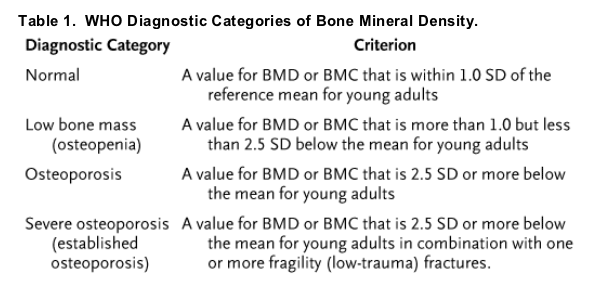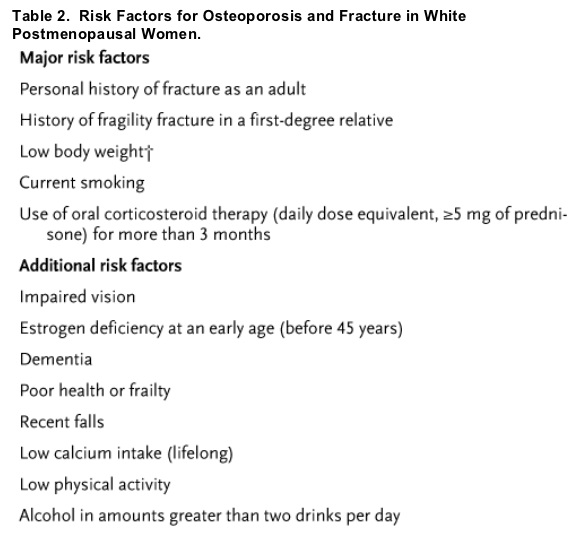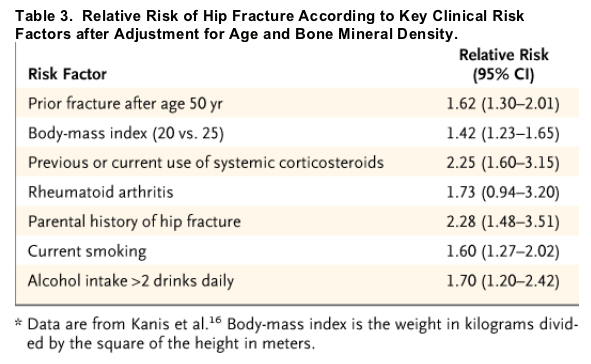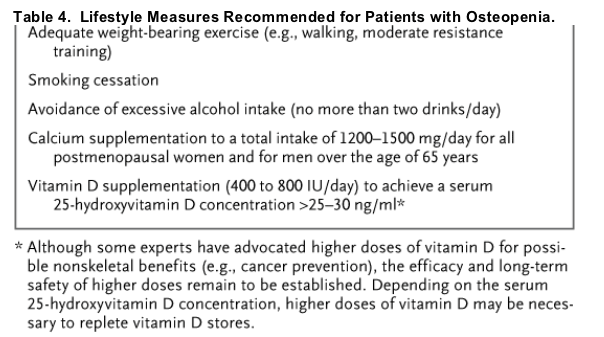| |
Osteopenia: intervention & therapy
|
| |
| |
NEJM May 31, 2007
Sundeep Khosla, M.D., and L. Joseph Melton, III, M.D., M.P.H.
From the Endocrine Research Unit, Division of Endocrinology and Metabolism, Department of Internal Medicine, and the Division of Epidemiology, Department of Health Sciences Research, Mayo Clinic College of Medicine, Rochester, MN.
From Jules: It appears to me that bone disease may take a different path in HIV than in the general population. We may not know this without further study but there is NO ongoing study now to examine this. There are many reasons to suspect that HIV related bone disease may take a different path of disease development, perhaps more virulent, as in HIV/HCV coinfection, where HIV can significantly accelerate HCV disease. A number of studies in HIV find 65% of patient participants have osteopenia but more noteworthy is that the average age of the patients is in the mid-40s. The risk factors in HIV-infected appear to have a different number of risk factors, prevalence of risk factors, and degree of severity on average. Traditional risk factors of alcohol and smoking are more prevalent in HIV. Methadone use may be a risk factor. Diabetes may be a risk factor. HIV appears to be a risk factor by perhaps altering the immunology of bone metabolism. ART may again have an impact on the immunology of bone metabolism. Does HCV or peginterferon/ribavirin therapy have an affect, some studies say yes? Studies show glitazones cause bone loss. It appears that bone disease pathogenesis may be different in HIV, but more study is required to address the questions.
"......osteopenia is analogous to prehypertension,7 impaired fasting glucose,8 and borderline high cholesterol9 in defining an intermediate-risk group with somewhat uncertain boundaries. Although the risk of fracture is greater among patients with osteoporosis than among those with osteopenia, the much larger number of persons with osteopenia means that this group represents a substantial portion of the population at risk for fracture.....measurement of bone mineral density alone cannot effectively discriminate between those patients with osteopenia who will have fractures and those who will not. Clinical risk factors should be considered in combination with measurements of bone mineral density to estimate fracture risk and guide intervention......Since definitive evidence for or against the use of such therapy in patients with osteopenia is lacking, the patient's own valuation of risks and benefits should influence the choice. Unless the patient strongly prefers to take antiresorptive medication or has a T score near the osteoporotic range (e.g., below -2) with several risk factors for fracture, encouragement of lifestyle modifications with reassessment in 2 to 3 years is a reasonable strategy and is our recommendation for the majority of patients with osteopenia..... Decisions regarding pharmacologic therapy must take into account the long period of treatment (generally prescribed for at least 5 to 10 years and sometimes indefinitely) and its substantial costs and potential side effects. Certain additional risk factors for fracture (e.g., documented vertebral fractures or prolonged use of glucocorticoid therapy) would clearly warrant pharmacologic therapy. In the absence of such compelling indications, counseling combined with follow-up assessment of bone mineral density is a reasonable strategy. If follow-up testing shows decreases in bone mineral density that exceed those reflecting the variability that is attributable to the measuring equipment (i.e., greater than the least significant change,43 which is generally a change of more than 3 to 4%), pharmacologic therapy can be considered for prevention of further bone loss. Therapy should be instituted if the values on follow-up testing are in the osteoporotic range."
This Journal feature begins with a case vignette highlighting a common clinical problem. Evidence supporting various strategies is then presented, followed by a review of formal guidelines, when they exist. The article ends with the authors' clinical recommendations.
A 55-year-old asymptomatic woman, who is 5 years postmenopausal, is concerned about osteoporosis, since her mother had a hip fracture at the age of 70 years. The patient has no personal history of fractures and has never taken corticosteroids. She does not smoke but does drink one to two glasses of wine a day. Her weight is 105 lb (48 kg), and her height is 62 in. (1.6 m); she has a body-mass index (the weight in kilograms divided by the square of the height in meters) of 19.2. Measurements of bone mineral density with the use of dual-energy x-ray absorptiometry show T scores of -1.7 at the spine and -1.5 at the femoral neck, findings that are consistent with osteopenia. What should you advise?
The Clinical Problem
It has long been known that fractures in elderly persons are associated with bone fragility,1 but not until the advent of bone densitometry has that assessment been standardized.2 Bone mineral density (expressed in grams per square centimeter) is a better predictor of fractures than blood pressure is of stroke, with a relative risk of hip fracture of 2.6 for each 1 SD decrease in bone mineral density at the hip.3 Like the relation between blood pressure and the risk of stroke, the relation between bone mineral density and the risk of fracture is continuous, with no absolute cutoff value to define a pathologic state. According to a working group of the World Health Organization (WHO), osteoporosis is defined as a T score of -2.5 or lower (i.e., bone mineral density that is 2.5 SD or more below the normal mean value for young adults), and osteopenia as a T score that is higher than -2.5 but less than -1.0 (Table 1).4

By this criterion, an estimated 33.6 million Americans - 80% of them women - have osteopenia.5 The value of labeling such patients, whose bone mineral density may be within the normal range, has been questioned,6 but osteopenia is analogous to prehypertension,7 impaired fasting glucose,8 and borderline high cholesterol9 in defining an intermediate-risk group with somewhat uncertain boundaries. Although the risk of fracture is greater among patients with osteoporosis than among those with osteopenia, the much larger number of persons with osteopenia means that this group represents a substantial portion of the population at risk for fracture. For example, in the National Osteoporosis Risk Assessment Study,10 which involved 149,524 postmenopausal white women recruited from primary care practices who were followed for 1 year, there were so many more women with osteopenia than with osteoporosis (39% vs. 6%) that the number of fractures observed was greater among those with osteopenia (Figure 1).
Strategies and Evidence
The clinical dilemma posed by osteopenia typically arises when bone mineral density tests are ordered for patients without an obvious indication for osteoporosis treatment, such as a clinically evident vertebral fracture.11 This problem can be mitigated by following recommendations for osteoporosis screening delineated in a previous review in the Journal12 - for example, testing persons who are 65 years of age or older and those who have risk factors for bone loss or falls, as summarized in Table 2. Such screening helps identify a population of patients whose risk of fracture is sufficiently great that therapy is viewed as cost-effective,13 an important consideration, given the large number of people with osteopenia. It has also been suggested that attention should be focused on the lower part of the osteopenic range (e.g., using a T score below -2.0 to identify those at risk, as is done in many clinical trials, rather than a T score below -2.5, the cutoff for the diagnosis of osteoporosis). Although this approach would identify a greater percentage of the at-risk population, it would also result in the evaluation and treatment of more people who have a low risk of fracture.

Effective fracture prediction can be improved, however, by combining measurements of bone mineral density with clinical risk factors.14 A WHO working group was established in 2004 to define a set of clinical risk factors that would be easy to assess in primary care practice and would predict the risk of fracture (independently of bone mineral density) in both sexes, various ethnic groups, and various geographic regions.15 Combining data from large community-cohort studies (60,161 subjects followed for 254,582 person-years, with 5563 fractures observed), the group identified a number of robust clinical risk factors.16 Table 3 shows the relative risk of hip fracture associated with each clinical risk factor, after adjustment for age and bone mineral density. In conjunction with measurements of bone mineral density, these factors could be used to estimate the likelihood of an osteoporotic fracture, just as the risk scores in the Framingham Heart Study are used to predict the relative risk of heart disease.17 Algorithms that incorporate these risk factors along with measurements of bone mineral density and age are being developed to calculate 10-year absolute probabilities of fracture among white and nonwhite women and men in the United States.

Additional Testing
Additional testing may help identify patients with osteopenia who are at increased risk for fracture as compared with others with similar values for bone mineral density.
Assessment for Vertebral Fractures
The single best predictor of fractures is a previous osteoporotic fracture,18 but vertebral fractures may not be clinically apparent.19 In asymptomatic patients with osteopenia, radiography is thus a useful tool for uncovering any unrecognized vertebral fractures.20 Given its cost and the radiation exposure, however, a good alternative is vertebral-fracture assessment with the use of dual-energy x-ray absorptiometry,21 which is cheaper and requires less radiation. Use of dual-energy x-ray absorptiometry to detect vertebral factures involves obtaining images of the lateral spine and requires a newer machine with this capability, special software, and specially trained technicians. The sensitivity and specificity of vertebral-fracture assessment for detecting moderate or severe fractures, with spinal radiographs used as the gold standard, are estimated to be 87 to 93%, and 93 to 95%, respectively.21 Thus, dual-energy x-ray absorptiometry combined with vertebral-fracture assessment may be a relatively cost-effective way to identify unrecognized vertebral fractures in otherwise asymptomatic patients with osteopenia.21
Markers of Bone Turnover
Another possible approach to identifying patients with osteopenia who have accelerated bone loss is to measure biochemical markers of bone turnover. Since bone resorption and bone formation are coupled processes, markers of resorption (urinary or serum C-terminal and N-terminal cross-linked telopeptides of type I collagen) and formation (bone-specific alkaline phosphatase, osteocalcin, and N-terminal propeptide of type I collagen) can be used to assess the rate of bone remodeling.22 In population-based studies, increased bone turnover is associated with an increased risk of fracture, independently of bone mineral density, and with a higher likelihood of accelerated bone loss.23 However, the usefulness of bone-turnover markers in improving the ability to predict fracture risk in individual patients has been hampered by biologic and assay variability,24 and the routine use of these markers in the evaluation of patients with osteopenia cannot be recommended at this time.
Other laboratory testing in patients with osteopenia should be dictated by clinical judgment.25 Serum calcium and phosphorus levels and tests of renal and hepatic function may be warranted in some cases, and measurement of thyroid-stimulating hormone may identify women with hyperthyroidism that is not clinically obvious. Some clinicians perform more aggressive laboratory evaluation in patients with values for bone mineral density that are 2 SD or more below the mean value for women of the same age (i.e., a z score of -2 or or lower). Given the increasing recognition that vitamin D deficiency (a 25-hydroxyvitamin D level below 15 ng per milliliter [37 nmol per liter]) and insufficiency (a 25-hydroxyvitamin D below 25 to 30 ng per milliliter [62 to 75 nmol per liter]) are common in postmenopausal women and may contribute to bone loss,26 serum 25-hydroxyvitamin D levels should be measured with a reliable assay. Vitamin D deficiency should be treated before initiating pharmacologic therapy.
Watchful Waiting versus Pharmacologic Intervention
After excluding possible secondary causes of bone loss, the clinician must decide whether to recommend appropriate lifestyle changes and then reassess bone mineral density at a follow-up visit (typically in 1 to 3 years) or to initiate pharmacologic therapy in addition to lifestyle modifications.
Lifestyle Modifications
Table 4 lists the standard lifestyle interventions generally recommended for patients with osteopenia. A total intake of 1200 to 1500 mg of calcium per day (through diet, supplements, or both) and 400 to 800 IU of vitamin D per day is recommended for all postmenopausal women. A recent meta-analysis of 15 trials involving postmenopausal women showed that calcium supplementation (500 to 2000 mg daily) had small but significant favorable effects on bone mineral density at various sites (approximately a 2% increase over a period of 2 or more years), with a trend toward a reduction in vertebral fractures but no measurable effect on nonvertebral fractures.27 Similarly, a meta-analysis of 25 trials involving postmenopausal women showed that vitamin D supplementation (300 to 2000 IU daily) reduced the risk of vertebral fractures, with a trend toward reduced nonvertebral fractures,28 although heterogeneous studies were analyzed, including many involving elderly women with clinically significant vitamin D deficiency. Recent data from the Women's Health Initiative (WHI) in healthy postmenopausal women with baseline calcium and vitamin D intakes of approximately 1150 mg and 360 IU per day, respectively, showed that calcium and vitamin D supplementation (1000 mg and 400 IU, respectively), as compared with placebo, resulted in a small but significant increase in bone mineral density at the hip (1.06%), but did not significantly reduce hip fracture (the primary outcome) and increased the risk of kidney stones.29 However, since the mean calcium and vitamin D intakes in the placebo group were close to the currently recommended ranges, these data do not negate current recommendations for calcium and vitamin D intake.

Weight-bearing exercise is also recommended for the prevention of osteoporosis. A meta-analysis of 15 short-term trials (6 to 24 months) examining the effects of various supervised upper- and lower-body loading exercises, performed three to five times per week, on rates of bone loss in postmenopausal women30 concluded that such exercises modestly improved bone density. As compared with changes in control subjects, resistance training resulted in small increases in bone mineral density at the spine (mean increase, 0.006 g per square centimeter), with inconsistent findings for bone mineral density at the hip. Similarly, a meta-analysis of 10 trials showed that walking (90 to 280 minutes per week, generally divided into three to five sessions) had a small but significant effect on bone mineral density at the spine but not at the femur.31
Pharmacologic Therapy
The Food and Drug Administration has approved a number of drugs for the prevention of postmenopausal osteoporosis, including bisphosphonates (alendronate, risedronate, and ibandronate), a selective estrogen-receptor modulator (raloxifene), and oral or transdermal estrogens (Table 5). All of these agents attenuate ongoing bone loss,32,33,34,35,36 but there are limited data regarding their efficacy in reducing the risk of fracture in women with osteopenia. Although most clinical trials with fracture outcomes have involved women with T scores of -2.0 or less or women with prevalent vertebral fractures,32,33,34,35 trials of raloxifene37 and alendronate38 have shown a reduction of approximately 50% in the risk of vertebral fractures specifically in women with osteopenia. However, the data are conflicting; another trial39 failed to find a significant effect of alendronate on clinical fractures (vertebral and nonvertebral) in women with T scores above -2.5. The WHI trial showed that estrogen-progestin therapy reduced hip fractures by 33% and reduced all fractures by 24% in the population of women studied. On the basis of measurements of bone mineral density performed in approximately 6% of the WHI study population, most of the women had osteopenia or normal bone mineral density rather than osteoporosis40; whether the reduction in fracture risk occurred primarily in the subgroup of women (approximately 5%) with T scores below -2.5 rather than in the women with osteopenia is unclear. Furthermore, the increased risks associated with postmenopausal hormone use (including breast cancer, cardiovascular events, and dementia in older women) were considered to outweigh the benefits for bone, and other nonestrogen therapies are preferred when pharmacologic therapy is used.
Moreover, it is important to note that even a 50% relative reduction in the risk of fracture would have only a modest effect on the absolute fracture risk for the majority of women with osteopenia. For example, in an average 55-year-old woman with a T score of -1.5, pharmacologic therapy would be expected to reduce the estimated 10-year risk of fracture associated with osteoporosis from 8 to 4%,41 and this may not represent a cost-effective use of health care resources.42
Decisions regarding pharmacologic therapy must take into account the long period of treatment (generally prescribed for at least 5 to 10 years and sometimes indefinitely) and its substantial costs and potential side effects. Certain additional risk factors for fracture (e.g., documented vertebral fractures or prolonged use of glucocorticoid therapy) would clearly warrant pharmacologic therapy. In the absence of such compelling indications, counseling combined with follow-up assessment of bone mineral density is a reasonable strategy. If follow-up testing shows decreases in bone mineral density that exceed those reflecting the variability that is attributable to the measuring equipment (i.e., greater than the least significant change,43 which is generally a change of more than 3 to 4%), pharmacologic therapy can be considered for prevention of further bone loss. Therapy should be instituted if the values on follow-up testing are in the osteoporotic range.
Areas of Uncertainty
As discussed above, a key unresolved area is the ability to distinguish between women with osteopenia in whom antiresorptive therapy is warranted and those in whom lifestyle interventions are sufficient. An additional area of uncertainty is the relevance of bone mineral density at sites other than the hip in assessing fracture risk. The original definition of osteopenia by the WHO was based on measurements of bone mineral density at the hip in white women.44 Bone mineral density at the spine is also often measured, since this assessment may result in better detection of early postmenopausal bone loss,12 but its predictive value for fracture has been less well studied. Discrepancies in the apparent prevalence of osteopenia (as compared with that defined by hip bone mineral density) also arise when the T-score definitions are extended to include measurements of bone mineral density made with the use of techniques other than dual-energy x-ray absorptiometry (e.g., ultrasonography or computed tomography), at peripheral skeletal sites,45 or in patients who are members of minority groups46 (who have not been well studied47,48,49). Although this review focuses on postmenopausal women with osteopenia, there are even greater uncertainties in diagnosis and management among men and premenopausal women with low bone mass. Because body size influences values for bone mineral density that are obtained by dual-energy x-ray absorptiometry, such values are lower in women with small bones than in those with large bones, making the interpretation of a borderline value in a small woman particularly challenging. The optimal interval at which to obtain follow-up measurements of bone mineral density is also controversial. An interval of 2 to 3 years is often reasonable, but some clinicians recommend earlier follow-up (after 1 year), especially in patients with T scores of -2.0 or lower who are not receiving pharmacologic treatment.
Guidelines
Clinical practice guidelines from the National Osteoporosis Foundation,11 the American Association of Clinical Endocrinologists,50 and the North American Menopause Society51 all recommend treatment for patients with osteoporosis and those with a fracture, and they advise against treatment for patients with bone mineral density T scores that are higher than -1.0. However, recommendations for the management of osteopenia are inconsistent. For example, whereas the National Osteoporosis Foundation11 and the American Association of Clinical Endocrinologists49 suggest at least the consideration of pharmacologic therapy for women with T scores for bone mineral density that are less than -1.5 and additional risk factors, the North American Menopause Society51 recommends that this intervention be deferred until the T score is lower (-2.0 to -2.5), even with additional risk factors. The development of guidelines by the WHO that combine clinical risk factors with bone mineral density to estimate "absolute" fracture risk (i.e., the likelihood of fracture, expressed as a percentage, over a period of 10 years) may help reduce this controversy and facilitate informed decision-making.16
Conclusions and Recommendations
The goal of treating low bone mass is to prevent fracture-related morbidity and mortality, an important task, given that the lifetime risk of osteoporotic fracture is 40% for women and 13% for men, even among 50-year-old women and men at average risk.19 Because osteopenia is so much more common than osteoporosis, the majority of fractures occur in the population of patients with osteopenia,10,52 yet measurement of bone mineral density alone cannot effectively discriminate between those patients with osteopenia who will have fractures and those who will not. Clinical risk factors should be considered in combination with measurements of bone mineral density to estimate fracture risk and guide intervention.
The patient described in the vignette is lean and has a family history of hip fracture. She should be counseled on lifestyle measures, including adequate weight-bearing exercise, calcium supplementation to achieve a total intake of 1200 mg per day, and vitamin D supplementation to achieve a serum 25-hydroxyvitamin D concentration above 25 to 30 ng per milliliter (62 to 75 nmol per liter); we would recommend a minimum of 400 to 800 IU of vitamin D per day (more may be needed in some patients). The option of pharmacologic therapy should be discussed with the patient. Since definitive evidence for or against the use of such therapy in patients with osteopenia is lacking, the patient's own valuation of risks and benefits should influence the choice. Unless the patient strongly prefers to take antiresorptive medication or has a T score near the osteoporotic range (e.g., below -2) with several risk factors for fracture, encouragement of lifestyle modifications with reassessment in 2 to 3 years is a reasonable strategy and is our recommendation for the majority of patients with osteopenia.
Supported by grants from the National Institutes of Health (AG-004875 and AR-027065).
Dr. Khosla reports receiving consulting fees from GlaxoSmithKline and Novartis and lecture fees from Amgen. Dr. Melton reports receiving lecture fees from Procter & Gamble, Amgen, and Merck. No other potential conflict of interest relevant to this article was reported.
|
|
| |
| |
|
|
|